Unlocking the Power of Letters of Agreement With Our 27-Templates: Your Path to Successful Business Contracts
Welcome to Letters of Agreement: Your Guide to Effective Business Contracts! We understand the importance of clear and reliable contracts in today’s business world. Our platform offers a wide range of customizable letter templates to meet your specific needs, from employment agreements to partnership arrangements, licensing agreements to service contracts. With a focus on clarity and attention to detail, our templates encompass key elements such as parties involved, the scope of work, terms, and conditions, payment details, and timelines. We aim to empower you with the knowledge and tools to create agreements that establish trust, set clear expectations, and contribute to successful collaborations. Explore our resources and embark on a journey towards more secure and prosperous business dealings with Letters of Agreement.
Importance of Agreement Letters
- Clear Expectations: Letters of agreement help establish clear expectations between parties involved in a business or legal arrangement. They outline the terms and conditions, scope of work, and other crucial details, ensuring everyone is on the same page.
- Legal Protection: Letters of agreement serve as legally binding documents that protect the interests of all parties. In the event of disputes or misunderstandings, the letter of agreement can serve as evidence of the agreed-upon terms, minimizing legal risks.
- Documentation: These letters provide written documentation of the agreement, including key elements such as timelines, payment terms, deliverables, and responsibilities. Having everything in writing reduces the likelihood of miscommunication or memory lapses.
- Clarity and Transparency: By clearly outlining the terms and conditions, letters of agreement promote transparency and prevent misunderstandings. Each party knows what is expected of them and what they can expect from others, fostering a sense of trust and cooperation.
- Mitigating Risks: Letters of agreement address potential risks and liabilities, protecting parties from unforeseen circumstances. They can include clauses for dispute resolution, termination, intellectual property rights, confidentiality, and other important considerations.
- Professionalism: Utilizing letters of agreement demonstrates professionalism and seriousness in business dealings. It shows that the parties involved take their responsibilities and obligations seriously, which can build trust and credibility.
- Relationship Management: Letters of agreement help manage relationships between parties by setting clear boundaries and expectations. They can provide a framework for effective communication, collaboration, and problem-solving throughout the duration of the agreement.
- Future Reference: These letters serve as a reference point for the parties involved even after the agreement is completed. If there are any questions or disputes in the future, the letter of agreement can be referred to as a basis for resolution.
#1: Employment Letter of Agreement:
Outlines the terms and conditions of employment between an employer and an employee, including job responsibilities, compensation, benefits, and duration of employment. The Employment Letter of Agreement is an important document that lays out the terms and conditions of your employment. It serves as a written record of our agreement and ensures that we’re on the same page regarding your role, responsibilities, and compensation. We’ll outline your job title, the tasks you’ll be responsible for, the hours you’ll be working, and the various benefits and compensation you’ll receive. We’ll also specify the duration of your employment, whether it’s a permanent position, temporary arrangement, or for a specific project. This letter aims to create clarity and prevent any misunderstandings so that we can build a positive and successful working relationship together.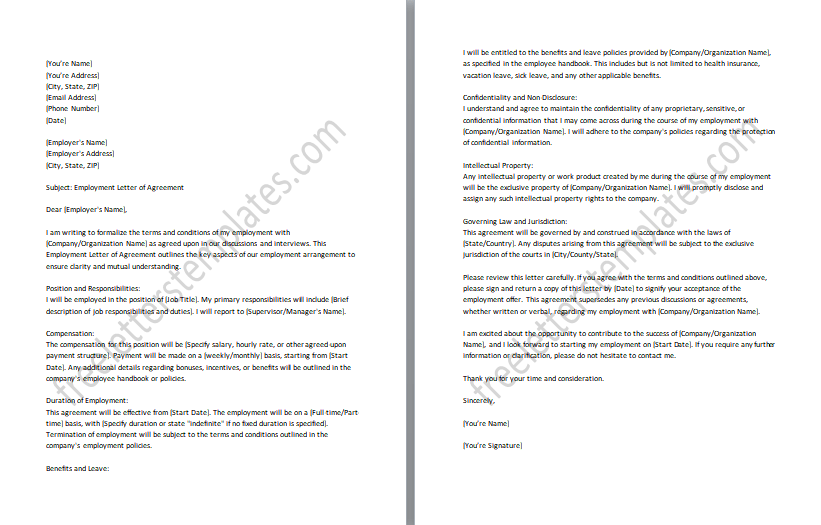
#2: Partnership Letter of Agreement:
Establishes the terms and conditions of a partnership between two or more individuals or entities, including profit-sharing, decision-making, and roles/responsibilities. The Partnership Letter of Agreement is a crucial document that lays down the terms and conditions of our partnership. It serves as a roadmap, ensuring that everyone involved understands their roles, responsibilities, and what we’re all striving to achieve together. We’ll discuss how we’ll share the profits, make important decisions, and divide the various tasks and duties among us. This agreement is designed to promote transparency, trust, and collaboration, setting the stage for a strong and harmonious partnership. By putting everything in writing, we can ensure that our partnership is built on a solid foundation and that we’re all on the same page from the start.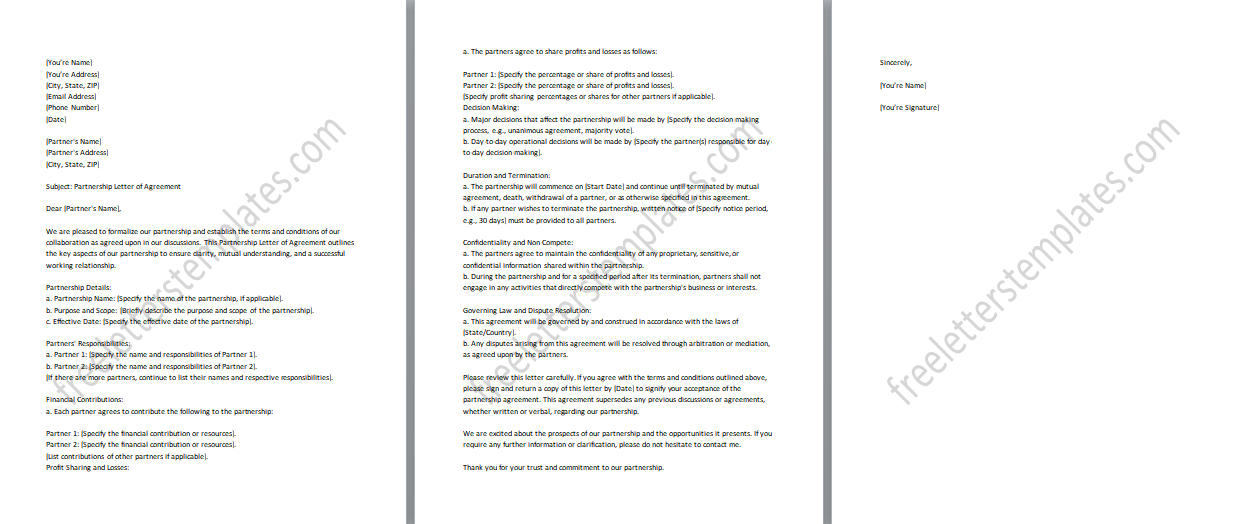
#3: Consulting Letter of Agreement:
Defines the scope of work, fees, and deliverables between a consultant and a client, ensuring clarity on the consulting engagement. The Consulting Letter of Agreement is a valuable document that clearly defines the scope of work, fees, and deliverables between a consultant and a client. It serves as a foundation for the consulting engagement, ensuring that both parties have a shared understanding of the project’s objectives and expectations. The agreement outlines the specific tasks and responsibilities that the consultant will undertake, the agreed-upon fees or compensation structure, and the anticipated deliverables or outcomes. Having this agreement in place promotes transparency, minimizes misunderstandings, and establishes a solid framework for the consulting relationship. Ultimately, it enables a successful collaboration and ensures that the client receives the desired value from the consultant’s expertise and services.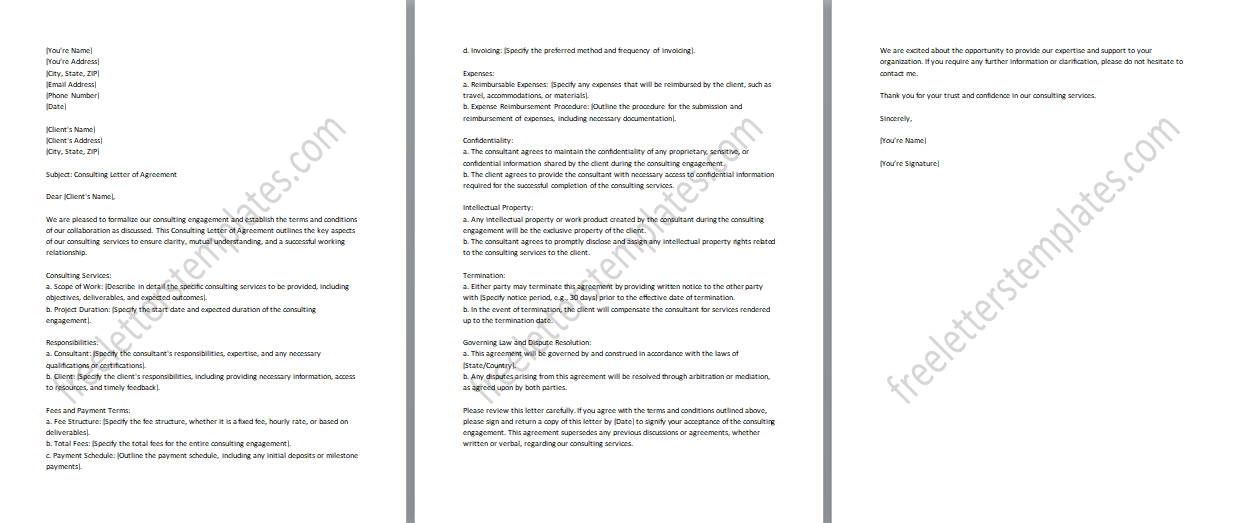
#4: Licensing Letter of Agreement:
Sets out the terms and conditions for granting a license to use intellectual property, such as trademarks, patents, or copyrighted material. The Licensing Letter of Agreement is a crucial document that establishes the terms and conditions for granting a license to use valuable intellectual property. This agreement is used when one party (licensor) grants another party (licensee) the right to use trademarks, patents, copyrighted material, or other intellectual property assets. The agreement outlines the specific rights granted, the scope of the license, any limitations or restrictions, and the duration of the licensing arrangement. It also addresses important considerations such as royalties or licensing fees, quality control measures, and any obligations or responsibilities of both parties. By setting clear terms and conditions, the Licensing Letter of Agreement helps protect the intellectual property owner’s rights while providing the licensee with the necessary permissions to utilize the intellectual property in a mutually beneficial manner.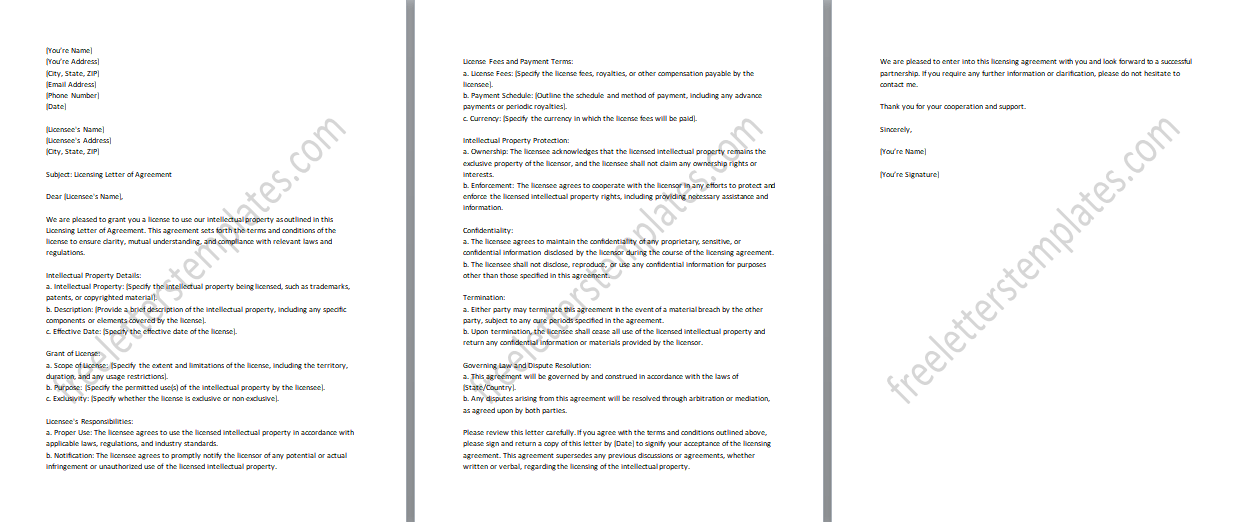
#5: Sales Letter of Agreement:
Documents the terms and conditions of a sale transaction between a buyer and a seller, including product details, pricing, payment terms, and delivery arrangements.
The Sales Letter of Agreement is a vital document that captures the terms and conditions of a sale transaction between a buyer and a seller. It serves as a written record of the agreement reached, ensuring that both parties are on the same page regarding the sale. The agreement includes crucial details such as product descriptions, pricing, payment terms, and delivery arrangements. It outlines the specific product or service being sold, its features, and any warranties or guarantees associated with it. The agreement also covers the pricing structure, including any discounts or additional charges, and the agreed-upon payment terms, such as upfront payment, installments, or payment upon delivery. Additionally, it includes provisions for delivery logistics, including shipping methods, timelines, and responsibilities. By documenting these details, the Sales Letter of Agreement helps establish clarity, minimize disputes, and facilitate a smooth transaction between the buyer and seller.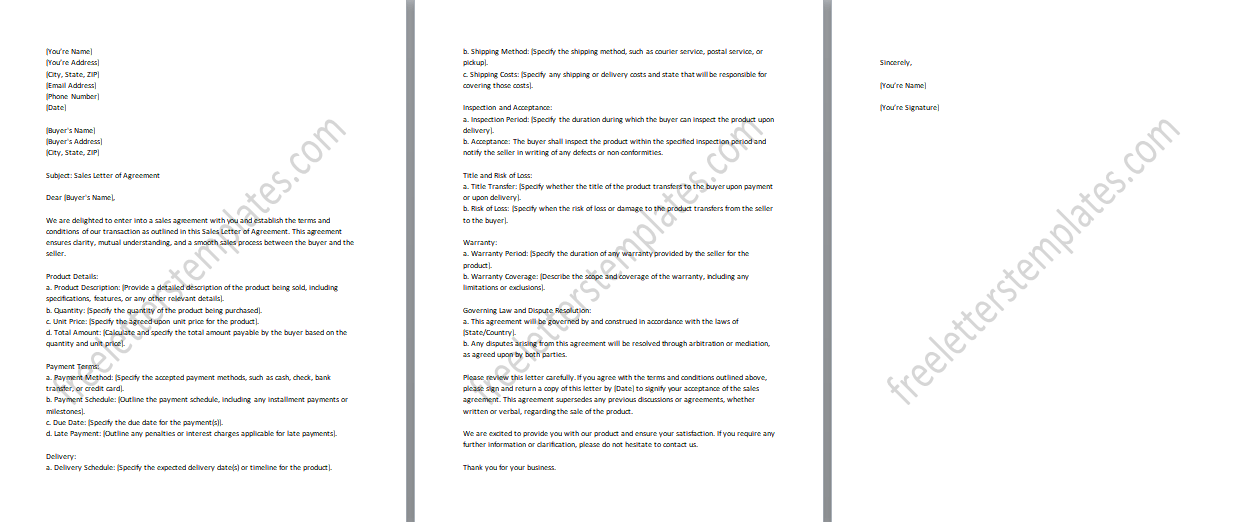
#6: Service Agreement Letter:
Defines the terms and conditions of a service agreement between a service provider and a client, including the scope of services, payment terms, and duration.
The Service Agreement Letter is a crucial document that helps us define the terms and conditions of our service agreement in a clear and understandable way. It’s like a roadmap that guides us through our collaboration, outlining the services we’ll provide, how we’ll be compensated, and how long our agreement will last. It’s all about ensuring that we’re on the same page, understanding each other’s roles and responsibilities, and creating a positive working relationship. By having this letter in place, we can communicate effectively, avoid any confusion or misunderstandings, and focus on delivering exceptional service to meet your needs. Together, we can make our collaboration a success!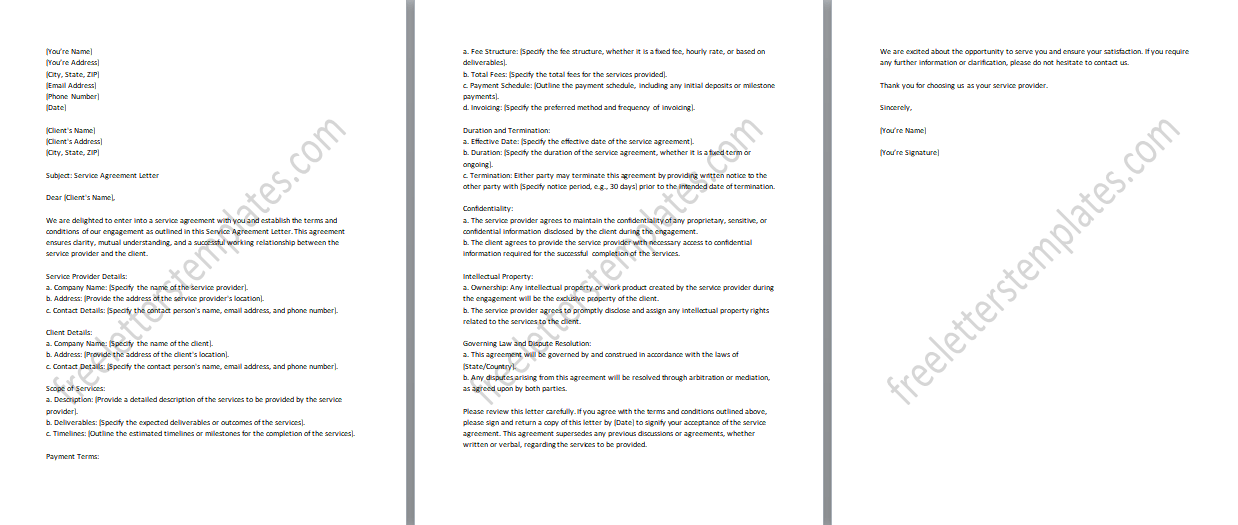
#7: Non-Disclosure Agreement Letter:
Establishes confidentiality obligations between parties to protect sensitive information shared during business discussions or collaborations.
The Non-Disclosure Agreement Letter is a vital document that helps establish confidentiality obligations between parties involved in business discussions or collaborations. Its purpose is to protect sensitive information that may be shared during our interactions. By signing this agreement, we ensure that any confidential or proprietary information disclosed will be kept confidential and not shared with unauthorized individuals or used for personal gain. This agreement helps build trust and creates a safe environment for open communication, encouraging the sharing of valuable insights and ideas without the fear of misuse or unauthorized disclosure. By maintaining confidentiality, we can foster a strong and secure working relationship based on mutual respect and the protection of sensitive information.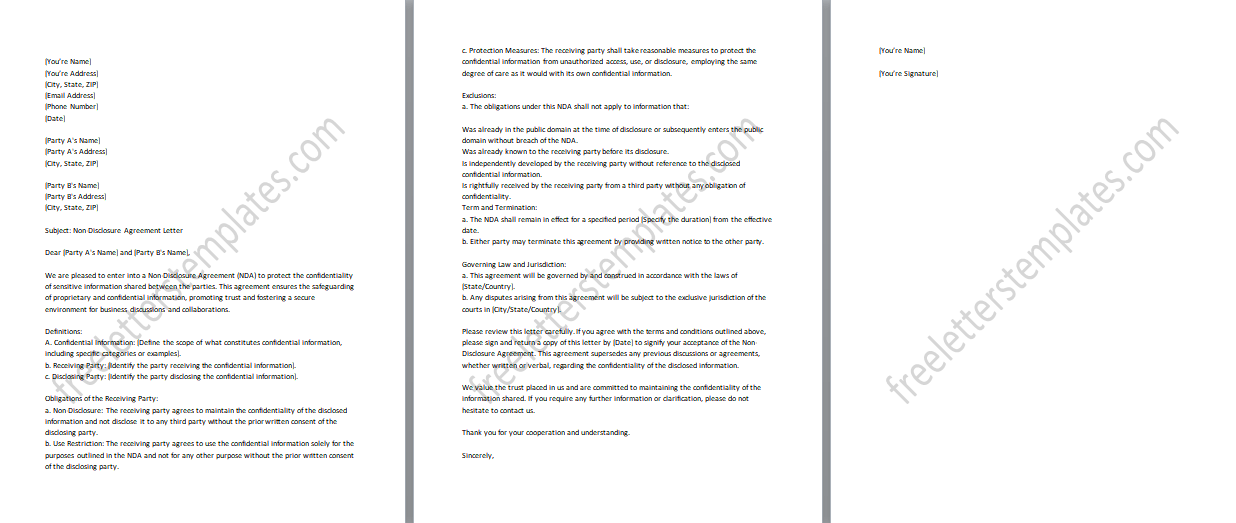
#8: Lease Agreement Letter:
Outlines the terms and conditions of a lease agreement between a landlord and a tenant, including rent, duration, maintenance responsibilities, and terms of termination.
The Lease Agreement Letter outlines the terms and conditions of a lease agreement between a landlord and a tenant. It includes details such as rent, duration, maintenance responsibilities, and termination terms. It ensures clarity and establishes a mutually beneficial relationship between both parties.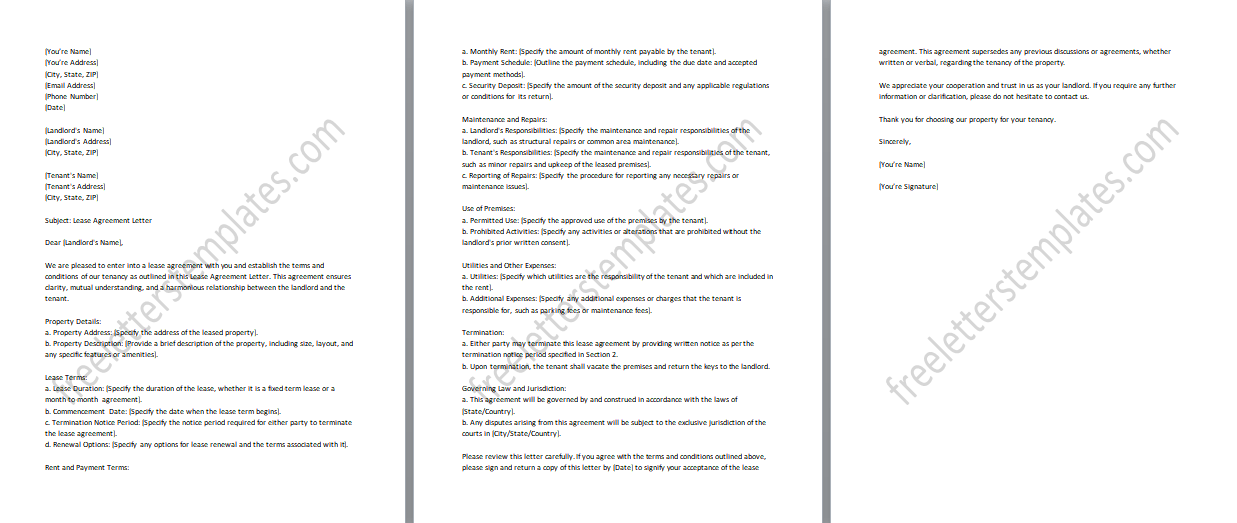
#9: Sponsorship Agreement Letter:
Details the terms and conditions of a sponsorship arrangement, including the obligations and benefits for both the sponsor and the recipient.
The Sponsorship Agreement Letter is a comprehensive document that provides the details of a sponsorship arrangement. It outlines the terms and conditions, including the obligations and benefits for both the sponsor and the recipient. The letter specifies the financial or in-kind support provided by the sponsor, as well as any specific deliverables or promotional opportunities for the recipient. It also defines the duration of the sponsorship and any rights or exclusivity associated with it. By capturing these essential elements, the Sponsorship Agreement Letter ensures a clear understanding between the parties involved, fostering a successful and mutually beneficial sponsorship relationship.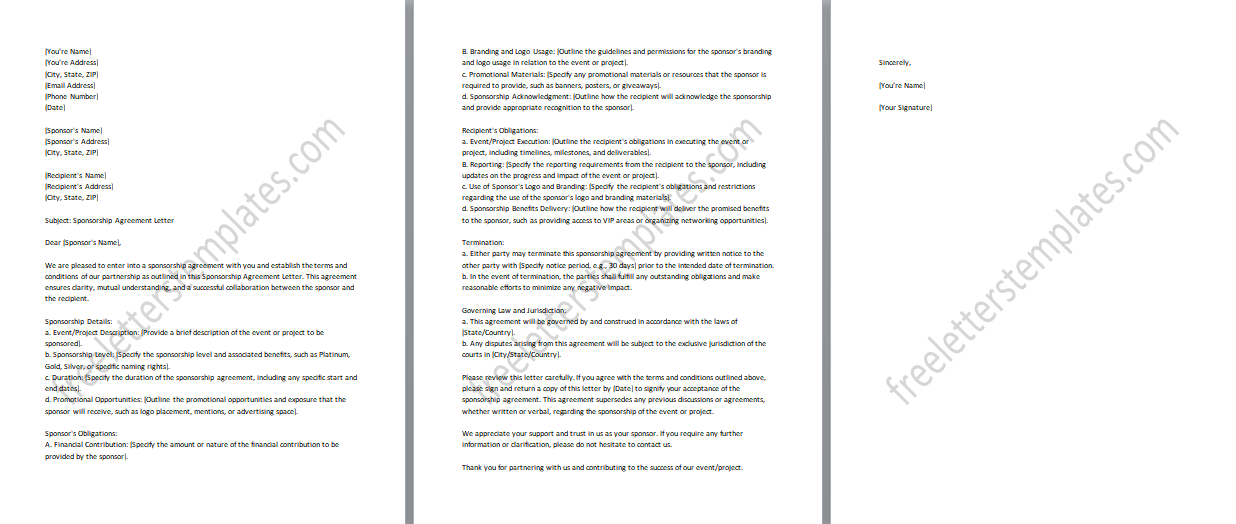
#10: Joint Venture Letter of Agreement:
Establishes the terms and conditions for a joint venture between two or more parties, including the purpose, contributions, profit-sharing, and decision-making.
The Joint Venture Letter of Agreement is a crucial document that paves the way for a collaborative and fruitful joint venture between multiple parties. It outlines the terms and conditions that govern our partnership, giving clarity to our purpose, contributions, profit-sharing, and decision-making processes. By establishing this agreement, we define our shared goals and objectives, spell out each party’s responsibilities, and determine how we’ll distribute profits or losses. Importantly, it ensures that we make key decisions together, harnessing the collective wisdom of all involved. This letter lays the groundwork for a strong and successful joint venture, enabling us to navigate the path ahead with confidence and cooperation.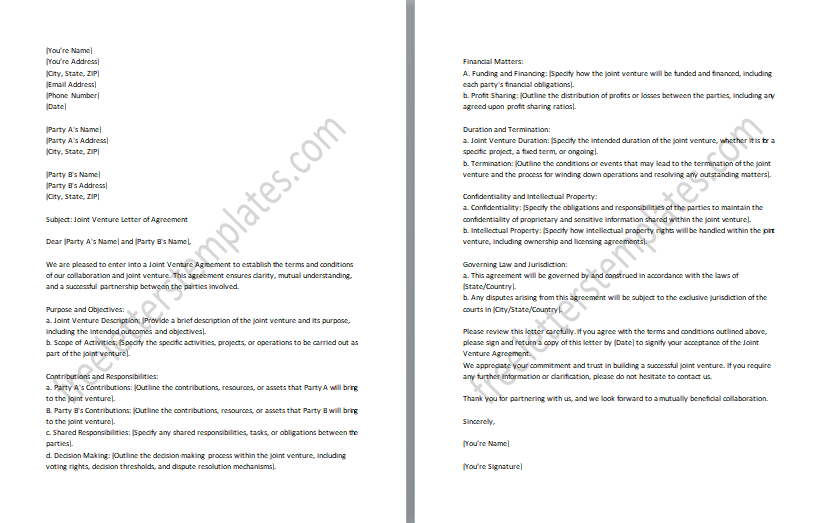
#11: Franchise Agreement Letter:
Defines the terms and conditions of a franchise arrangement, including the rights, obligations, and responsibilities of the franchisor and the franchisee.
The Franchise Agreement Letter is a crucial document that outlines the terms and conditions of a franchise arrangement. It serves as a guidebook that defines the rights, obligations, and responsibilities of both the franchisor and the franchisee. The letter covers important aspects such as the use of intellectual property, operational guidelines, training and support, financial obligations, and territory restrictions. It ensures that both parties understand their roles and responsibilities, fostering a harmonious and successful franchising relationship. By having this agreement in place, we establish a solid foundation for collaboration and growth, allowing the franchisee to leverage the franchisor’s brand and expertise while adhering to established standards and procedures.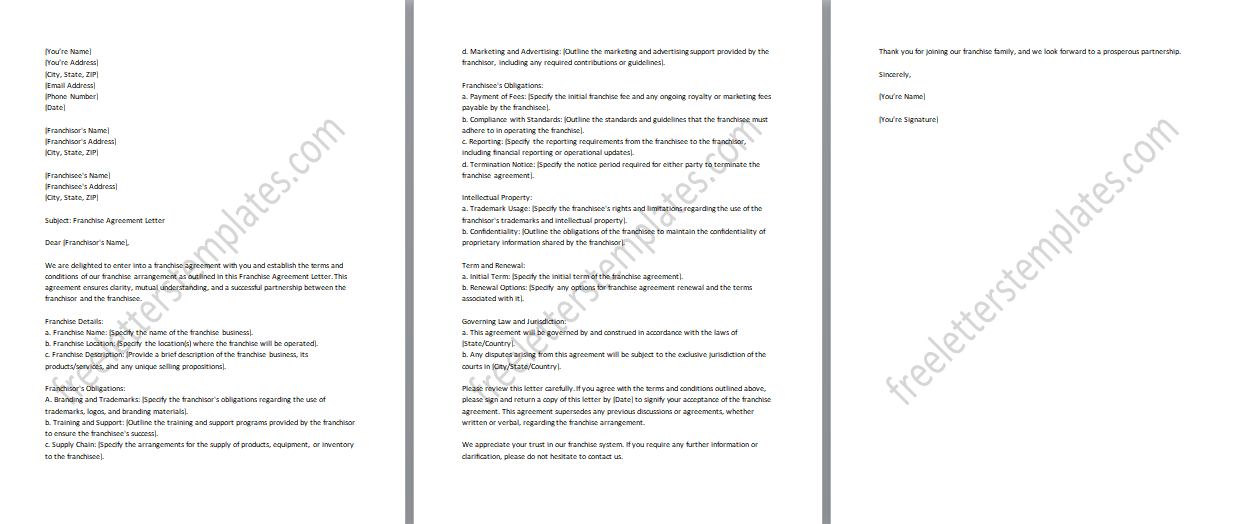
#12: Construction Agreement Letter:
Outlines the terms and conditions of a construction project, including the scope of work, timelines, payment terms, and responsibilities of the parties involved. The Construction Agreement Letter is a crucial document that outlines the terms and conditions of a construction project. It serves as a roadmap that guides the project, detailing important aspects such as the scope of work, timelines, payment terms, and responsibilities of all parties involved. The letter ensures that everyone has a clear understanding of their roles and obligations, minimizing the potential for misunderstandings or disputes. It outlines the project specifications, milestones, and deliverables, providing a clear framework for successful project completion. By having this agreement in place, we establish a solid foundation for effective communication, collaboration, and accountability throughout the construction process.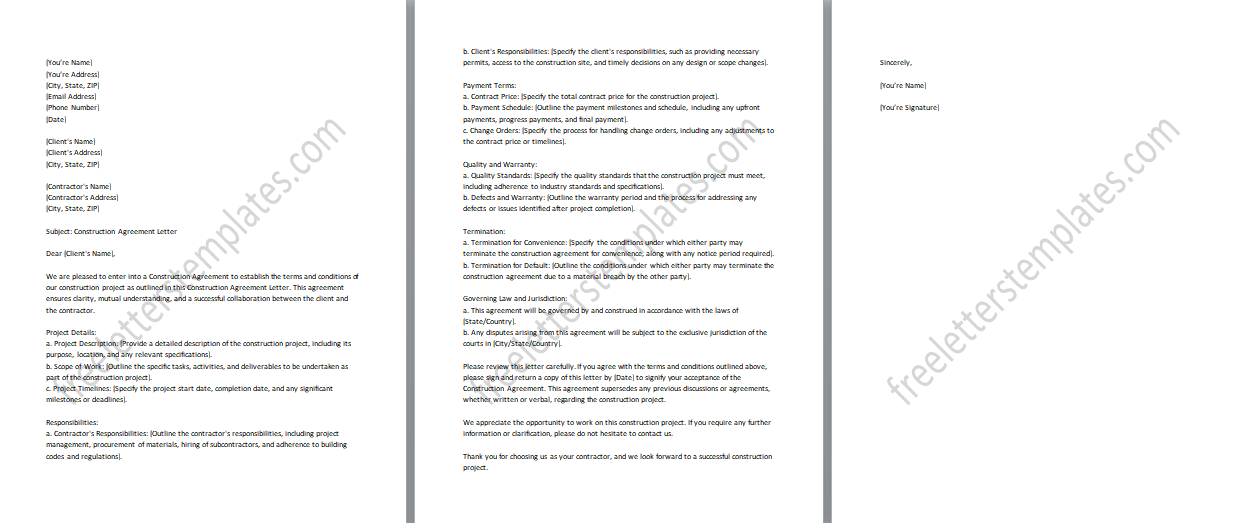
#13: Agency Agreement Letter:
Establishes the terms and conditions between a principal and an agent, including the authority granted, commission structure, and responsibilities. The Agency Agreement Letter is a vital document that establishes the terms and conditions between a principal and an agent. It serves as a binding contract that outlines the authority granted to the agent, the commission structure, and the responsibilities of both parties. The letter defines the scope of the agency relationship, including the agent’s power to act on behalf of the principal and make decisions within specified limits. It also specifies how the agent will be compensated for their services, whether through commissions, fees, or a combination of both. By having this agreement in place, we establish a solid foundation of trust and clarity, allowing both parties to collaborate effectively and achieve their respective goals.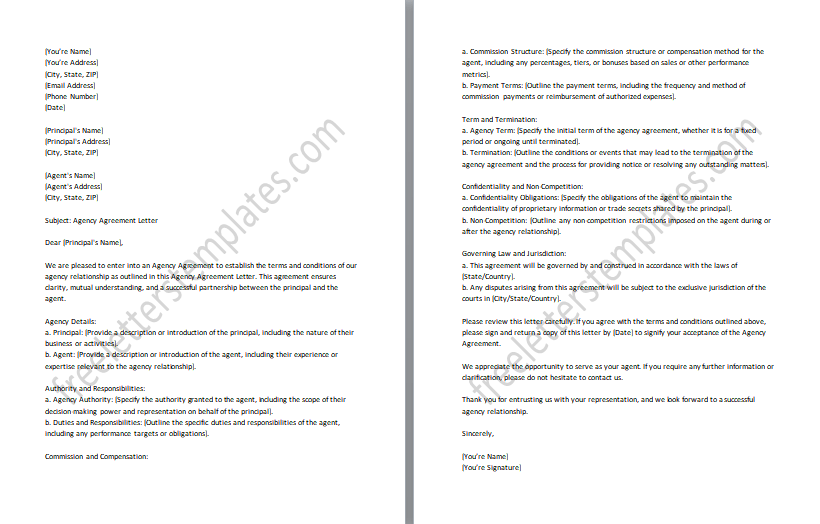
#14: Distribution Agreement Letter:
Sets out the terms and conditions for the distribution of products or services, including territories, pricing, marketing support, and termination provisions. The Distribution Agreement Letter sets out the terms and conditions for the distribution of products or services. It covers territories, pricing, marketing support, and termination provisions. The letter defines the distribution territories, establishes pricing guidelines, and outlines marketing support. It also includes provisions for termination if necessary. This agreement ensures a clear understanding and a mutually beneficial distribution relationship between the parties involved.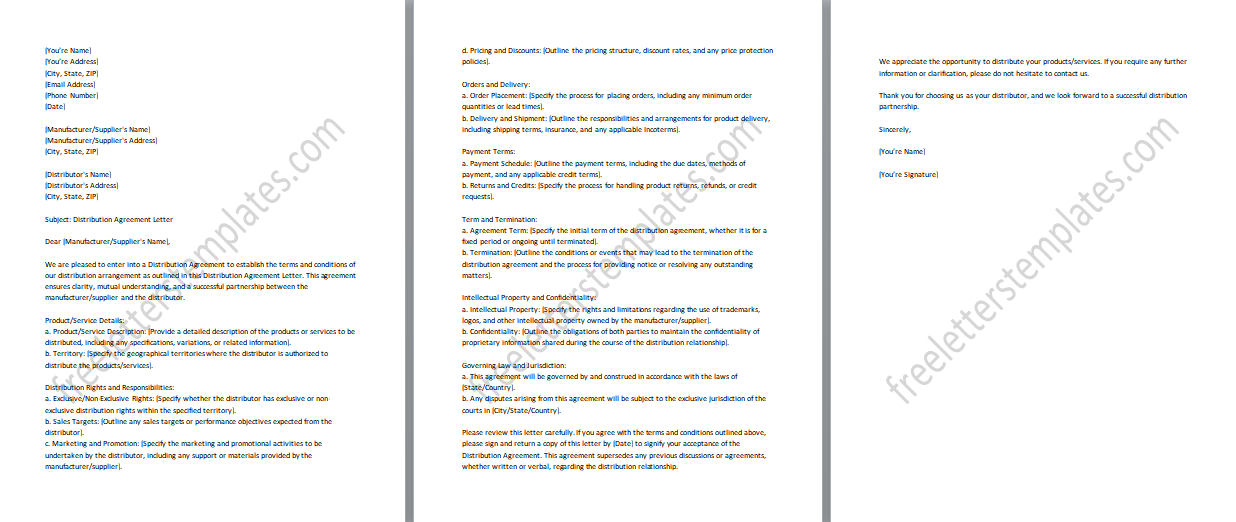
#15: Purchase Agreement Letter:
Documents the terms and conditions of a purchase transaction, including the item’s description, purchase price, delivery terms, and warranties. The Purchase Agreement Letter is a vital document that documents the terms and conditions of a purchase transaction. It encompasses essential details such as the description of the item being purchased, the purchase price, delivery terms, and any warranties provided. This agreement ensures that both the buyer and the seller have a clear understanding of their rights and obligations. It outlines the specifics of the transaction, including any agreed-upon delivery timelines or conditions. Additionally, the letter may address warranty provisions, specifying the length of the warranty period and the terms for any potential claims or returns. By having this agreement in place, both parties can proceed with confidence, knowing that the purchase transaction is legally binding and that the terms are clearly defined.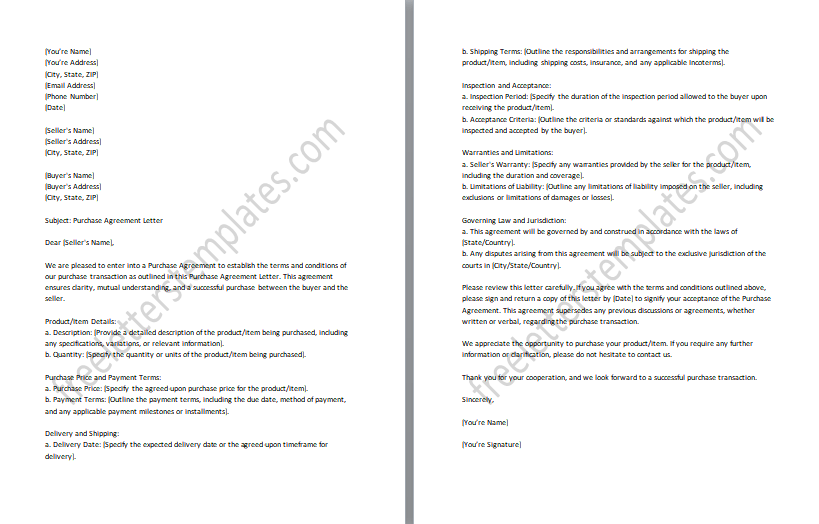
#16: Settlement Agreement Letter:
Outlines the terms and conditions of a settlement between parties involved in a dispute, including the resolution, compensation, and release of claims. The Settlement Agreement Letter is a crucial document that outlines the terms and conditions of a settlement between parties involved in a dispute. It serves as a written agreement that defines the resolution, compensation, and release of claims. The letter captures the mutually agreed-upon terms that put an end to the dispute, ensuring that both parties can move forward without any ongoing legal conflicts. It specifies the agreed-upon resolution, whether it’s a payment, performance of certain actions, or any other form of compensation. Additionally, the letter includes a release of claims, indicating that both parties agree not to pursue any further legal action related to the dispute. By having this agreement in place, both parties can achieve closure and avoid prolonged litigation, allowing them to focus on their respective interests and goals.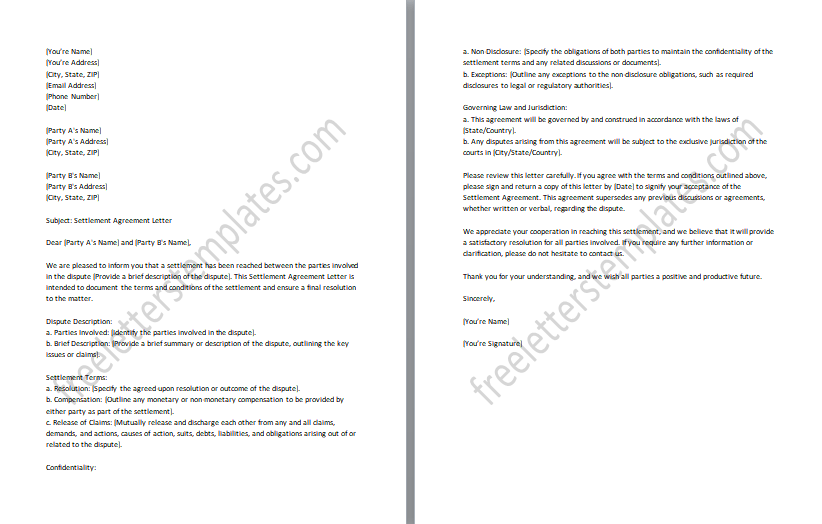
#17: Non-Compete Agreement Letter:
Establishes restrictions on an individual’s ability to compete with a business after leaving employment or a business relationship. The Non-Compete Agreement Letter is a crucial document that establishes restrictions on an individual’s ability to compete with a business after leaving employment or a business relationship. It serves as a binding contract that outlines the specific terms and conditions that the individual must adhere to in order to protect the business’s interests. The letter sets limitations on the individual’s ability to engage in similar business activities, work for competitors, or solicit clients or employees of the business. It typically includes a defined time period and geographical scope for the non-compete restrictions. By having this agreement in place, the business can safeguard its proprietary information, customer relationships, and trade secrets, while also providing clarity and protection for both parties involved.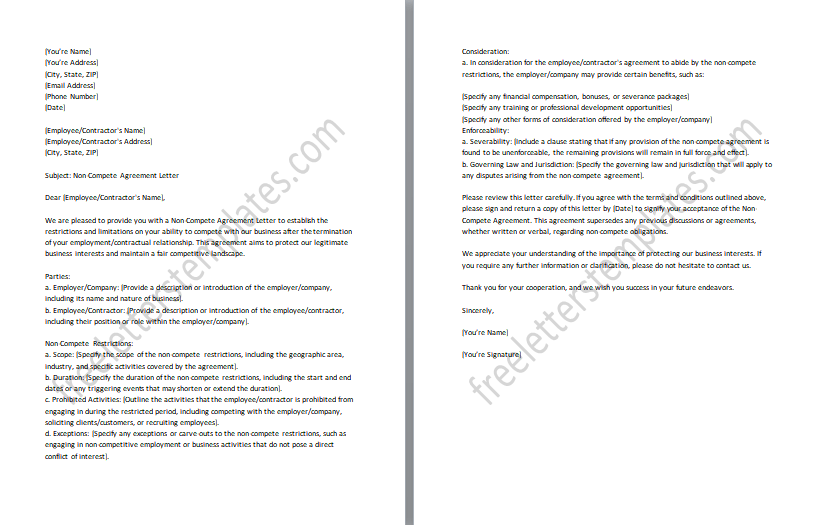
#18: Intellectual Property Agreement Letter:
Defines the terms and conditions for the use, protection, or transfer of intellectual property rights, such as copyrights, trademarks, or trade secrets. The Intellectual Property Agreement Letter is a crucial document that helps define the terms and conditions for the use, protection, or transfer of valuable intellectual property rights like copyrights, trademarks, or trade secrets. It ensures that both parties involved understand their rights and responsibilities regarding intellectual property. The letter outlines the permissions granted, any restrictions or limitations, and how long the agreement will last. By having this agreement in place, the parties can protect their valuable intellectual property assets, promote a collaborative environment for creativity and innovation, and have a clear understanding of how their intellectual property can be used and protected.
#19: Marketing Agreement Letter:
Sets out the terms and conditions of a marketing arrangement between two parties, including marketing strategies, promotional activities, and compensation. The Marketing Agreement Letter is a significant document that sets out the terms and conditions of a marketing arrangement between two parties. It outlines the specific details of the marketing partnership, including the agreed-upon marketing strategies, promotional activities, and compensation structure. It may cover areas such as target audience, advertising channels, branding guidelines, and performance metrics. Additionally, the agreement may address matters like exclusivity, termination provisions, and confidentiality of sensitive marketing information. By having this agreement in place, both parties can establish a clear understanding of their roles and responsibilities, work towards mutual marketing goals, and ensure a fair and productive marketing collaboration.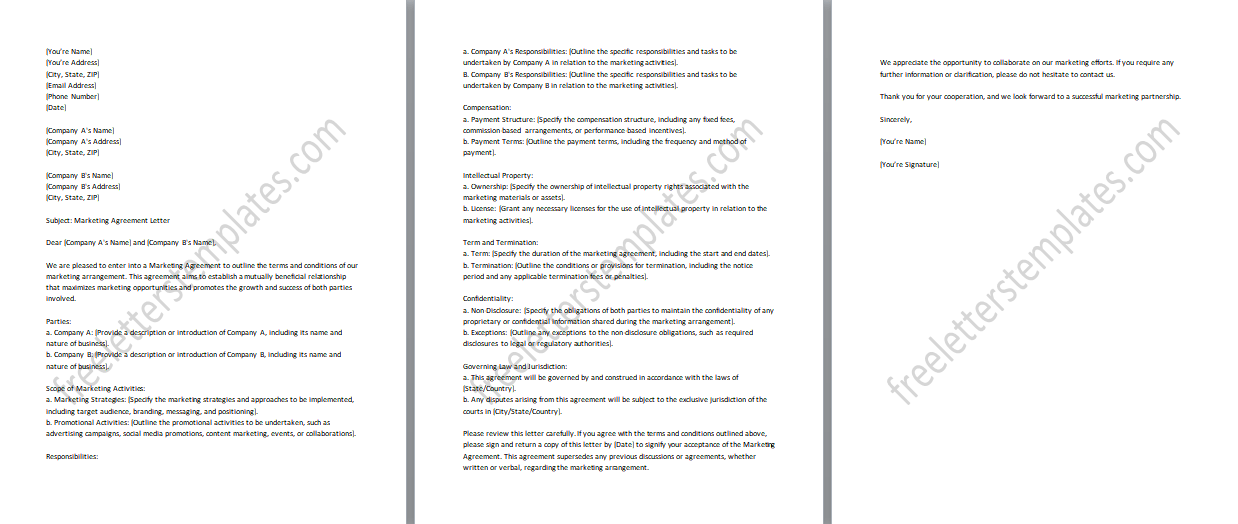
#20: Vendor Agreement Letter:
Establishes the terms and conditions between a vendor and a customer, including the supply of goods or services, pricing, delivery, and warranty provisions. The Vendor Agreement Letter is a crucial document that establishes the terms and conditions between a vendor and a customer. It outlines the specifics of the business relationship, including the supply of goods or services, pricing, delivery arrangements, and warranty provisions. It may cover aspects such as quantity, quality standards, payment terms, dispute resolution mechanisms, and any additional services or support provided by the vendor. By having this agreement in place, both the vendor and the customer can establish a clear understanding of the expectations, minimize potential conflicts, and foster a mutually beneficial business relationship.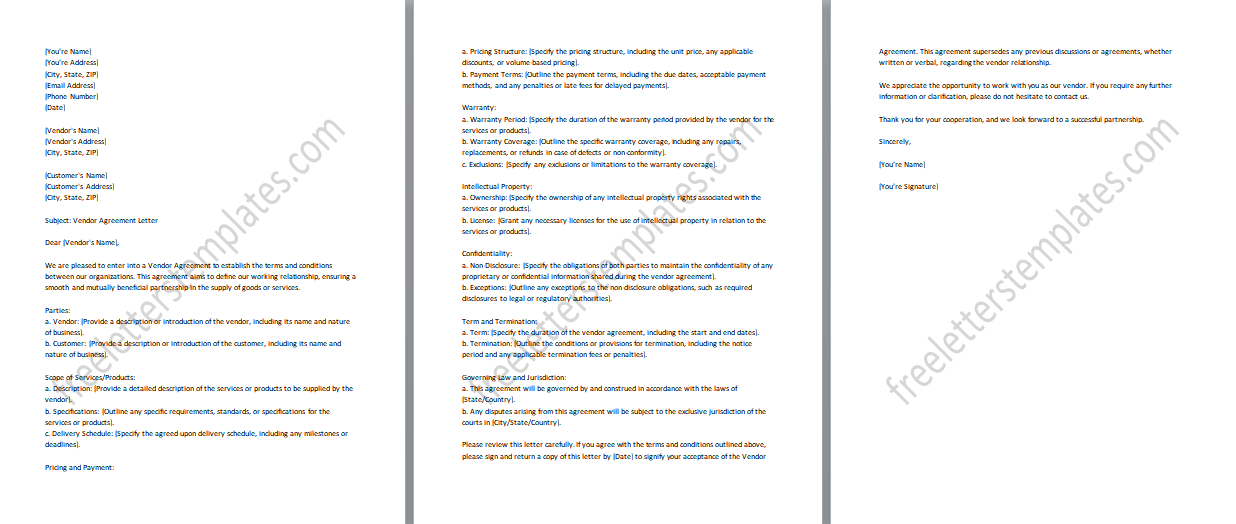
#21: Reseller Agreement Letter:
Outlines the terms and conditions for a reseller arrangement, including the rights, obligations, and responsibilities of the reseller and the supplier. The Reseller Agreement Letter is a critical document that outlines the terms and conditions for a reseller arrangement between a reseller and a supplier. The letter covers various aspects of the reseller relationship, including the products or services being resold, pricing and payment terms, territory restrictions, marketing and promotional activities, and support provided by the supplier. It may also address issues such as exclusivity, intellectual property rights, confidentiality, and termination provisions. By having this agreement in place, both the reseller and the supplier can ensure a clear understanding of their roles, protect their interests, and foster a successful and mutually beneficial reselling partnership.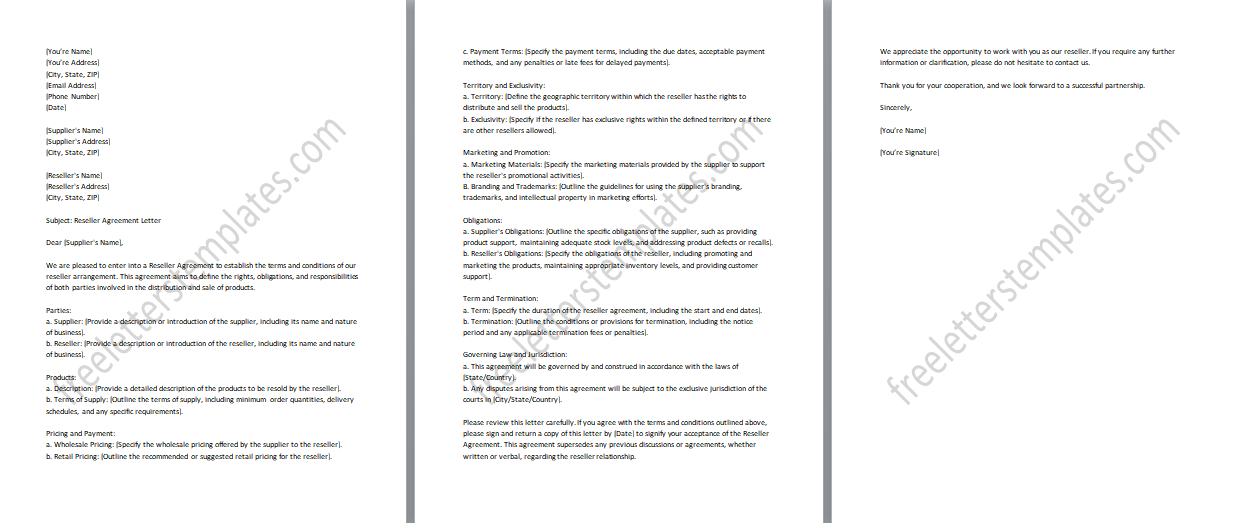
#22: Outsourcing Agreement Letter:
Defines the terms and conditions for outsourcing services, including the scope of work, service levels, pricing, and confidentiality provisions. The Outsourcing Agreement Letter is a crucial document that defines the terms and conditions for outsourcing services between a client and a service provider. It outlines the specific details of the outsourcing arrangement, including the scope of work, service levels, pricing, and confidentiality provisions. The letter serves as a contractual agreement that sets clear expectations and responsibilities for both parties involved. It covers aspects such as deliverables, timelines, quality standards, communication channels, and dispute-resolution mechanisms. By having this agreement in place, both the client and the service provider can establish a solid foundation for the outsourcing relationship and achieve the desired outcomes effectively and efficiently.
#23: Research Agreement Letter:
Sets out the terms and conditions for research collaboration, including the objectives, funding, data sharing, and intellectual property ownership. The Research Agreement Letter sets out the terms and conditions for research collaboration, including the objectives, funding, data sharing, and intellectual property ownership. It serves as a formal agreement that ensures clarity and mutual understanding among the collaborating parties. The letter covers aspects such as project timelines, roles, and responsibilities, confidentiality provisions, publication rights, and dispute resolution mechanisms. By having this agreement in place, all parties can establish a framework for successful research collaboration, protect their rights and interests, and facilitate effective knowledge and resource sharing.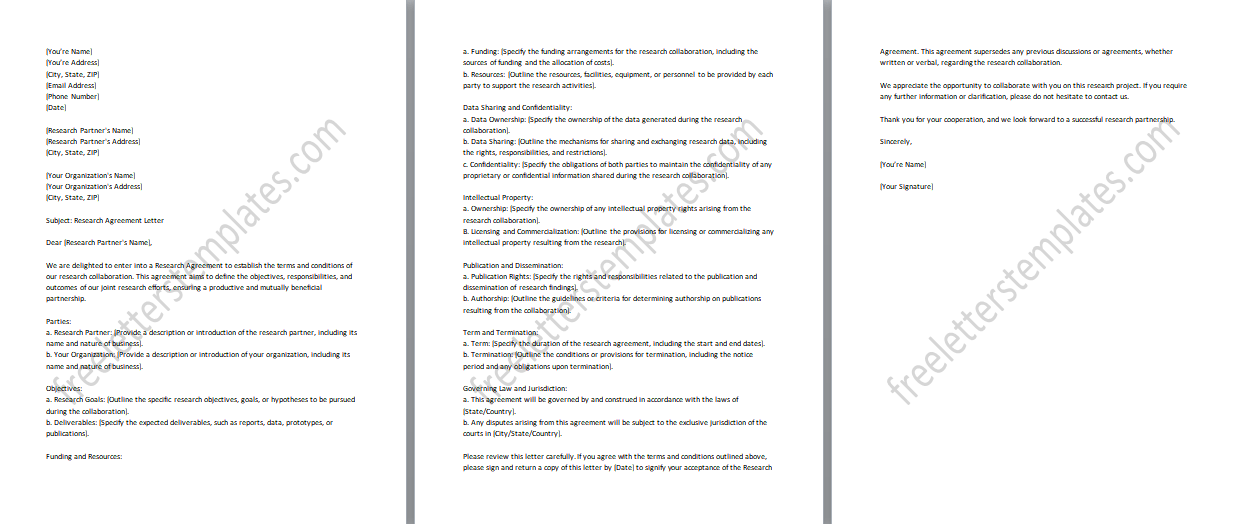
#24: Equipment Lease Agreement Letter:
Outlines the terms and conditions for leasing equipment, including the lease period, rent, maintenance responsibilities, and terms of termination. The Equipment Lease Agreement Letter is a document that outlines the terms and conditions for leasing equipment between a lessor (equipment owner) and a lessee (equipment user). It covers essential details such as the lease period, rental amount, maintenance responsibilities, and terms of termination. It may also include provisions related to insurance requirements, liability, repairs, and any additional fees or charges. By having this agreement in place, both the lessor and the lessee can ensure a smooth and mutually beneficial equipment leasing arrangement.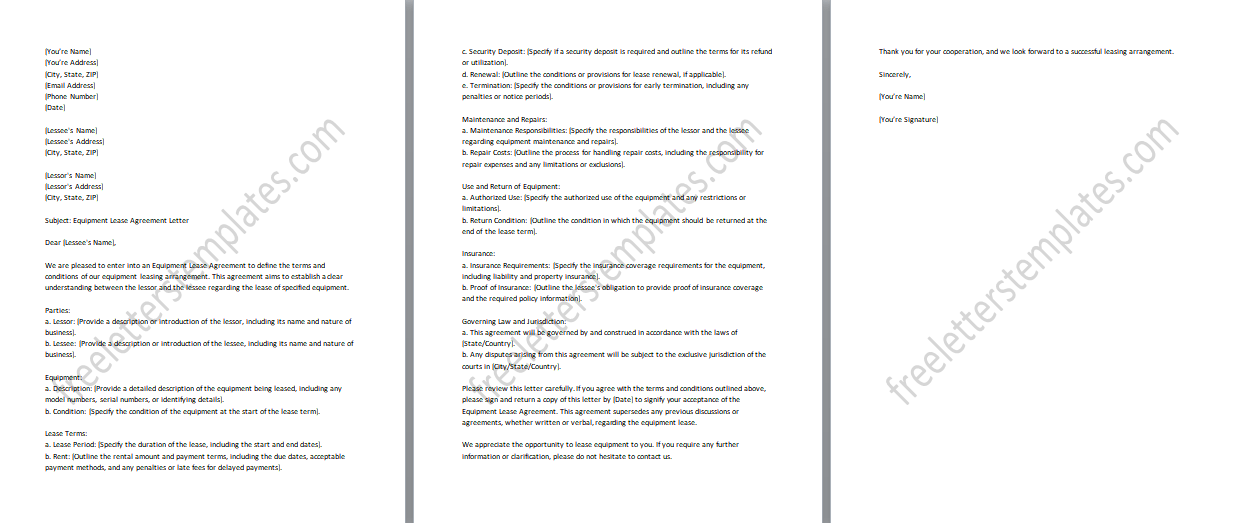
#25: Memorandum of Understanding (MOU):
Records the mutual understanding and intentions of parties involved in a potential agreement, often serving as a preliminary document before a formal contract is created. The Memorandum of Understanding (MOU) is a document that captures the shared understanding and intentions of parties involved in a potential agreement. It acts as an initial record, outlining the key terms, objectives, and responsibilities of each party before a formal agreement is finalized. It typically includes details about the involved parties, the purpose of the agreement, the scope of collaboration, and any financial or resource commitments. By establishing this MOU, the parties lay the groundwork for future negotiations and ensure a common understanding is in place.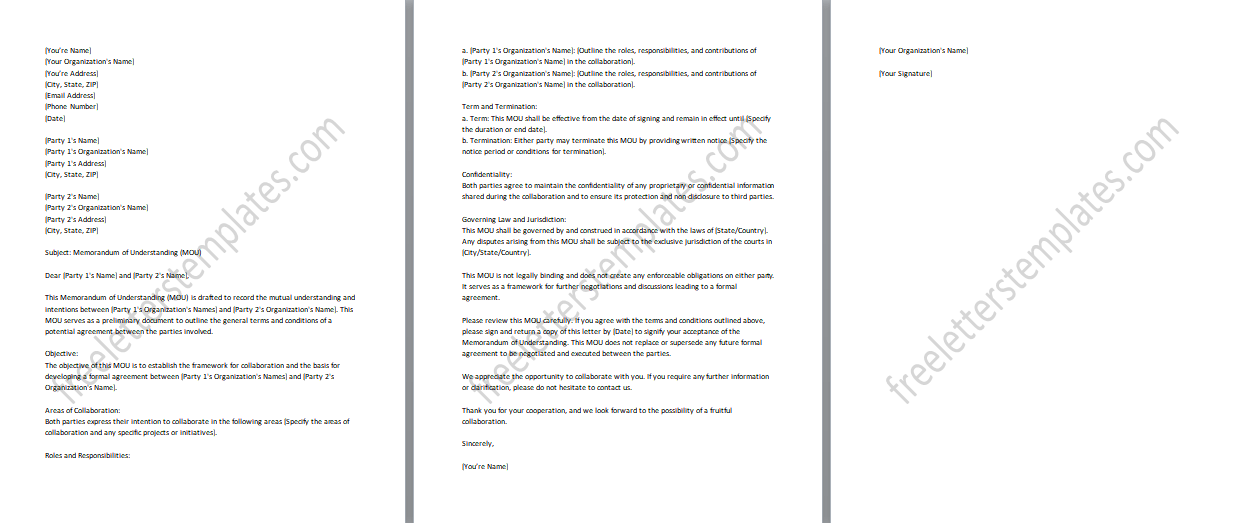
#26: Indemnity Agreement Letter:
Establishes the terms and conditions under which one party agrees to indemnify and hold another party harmless from specified risks, losses, or damages. The Indemnity Agreement Letter is a document that outlines the terms and conditions under which one party agrees to provide indemnification and hold another party harmless from specified risks, losses, or damages. It serves as a means of protection and assurance for the party being indemnified. By having this agreement in place, both parties can have peace of mind knowing that they are protected from potential risks and liabilities. It helps establish clarity and fairness in the event of unforeseen circumstances, ensuring that the indemnified party is safeguarded and their interests are protected.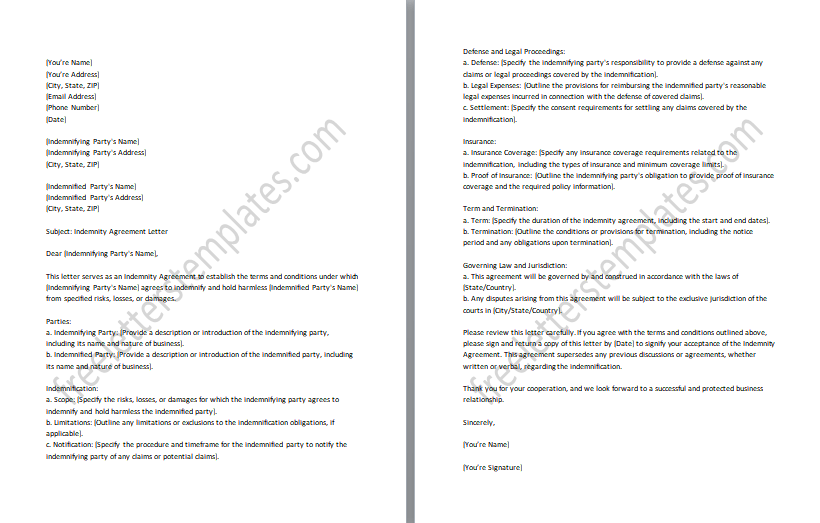
#27: Confidentiality Agreement Letter:
Outlines the terms and conditions of a confidentiality agreement to protect sensitive information disclosed between parties and restrict its use or disclosure. The Confidentiality Agreement Letter outlines the terms and conditions of a confidentiality agreement, protecting sensitive information shared between parties. It restricts the use or disclosure of this information. The agreement ensures the security and confidentiality of the shared data, preserving its value. It defines the responsibilities of each party in safeguarding the information and specifies the consequences for any breaches. By establishing this agreement, parties can confidently share sensitive information, knowing it will be treated with utmost care and confidentiality. It fosters trust and confidentiality in business relationships.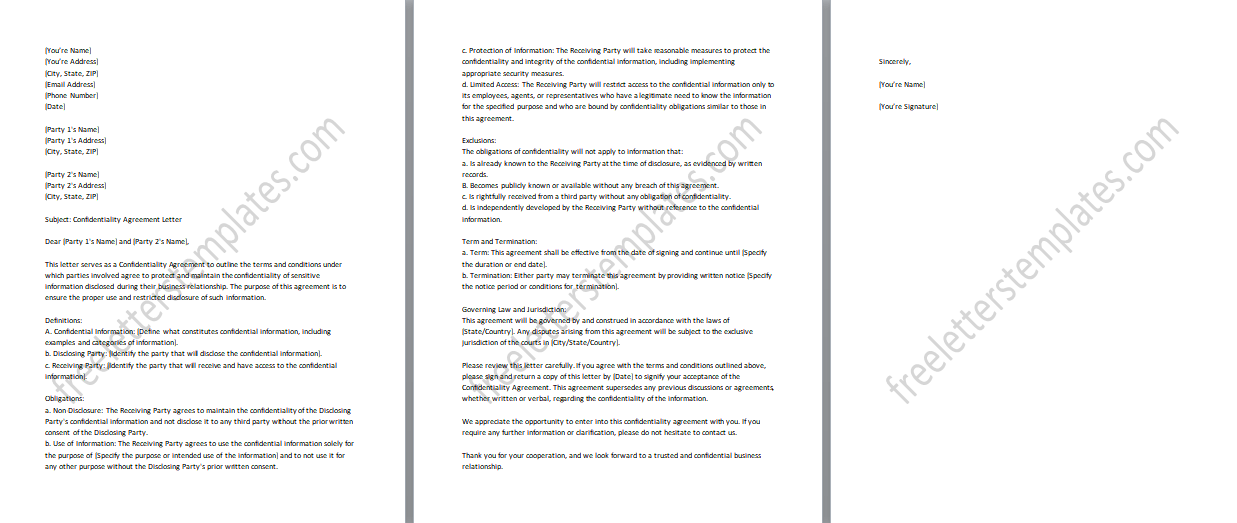
Clarity and Transparency
Clarity and transparency are vital aspects of any business or legal relationship, and letters of agreement play a crucial role in achieving these objectives. By clearly outlining the terms and conditions, a letter of agreement ensures that all parties involved have a comprehensive understanding of their roles, responsibilities, and obligations. It leaves no room for ambiguity or misunderstandings, as each party knows exactly what is expected of them and what they can expect from others. This promotes transparency, trust, and cooperation, as everyone is on the same page from the start. With a well-drafted letter of agreement, potential conflicts or disputes arising from miscommunication or differing interpretations can be minimized, leading to smoother and more successful collaborations.
- Clear communication: A letter of agreement provides a platform for clear and effective communication between the parties involved. It ensures that all important terms and conditions are clearly stated and understood by everyone.
- Prevents misunderstandings: By documenting the agreed-upon terms, a letter of agreement helps to prevent misunderstandings or misinterpretations of verbal agreements. It serves as a reference point for resolving any disagreements that may arise in the future.
- Establishes expectations: The letter of agreement sets clear expectations for all parties involved. It outlines the scope of work, timelines, deliverables, and any specific requirements, ensuring that everyone is aware of their responsibilities and obligations.
- Protects interests: A well-drafted letter of agreement includes provisions to protect the interests of all parties. This may include confidentiality clauses, intellectual property rights, indemnification provisions, and dispute resolution mechanisms, providing a layer of legal protection for the involved parties.
- Legal validity: A properly executed letter of agreement can have legal significance, particularly when it comes to enforcing the agreed-upon terms or resolving disputes. It serves as evidence of the mutual consent and understanding between the parties involved.
- Professionalism and credibility: Utilizing a letter of agreement demonstrates professionalism and credibility in business relationships. It shows that the parties involved take their commitments seriously and are committed to maintaining transparency and accountability.
- Reference for future use: A letter of agreement can serve as a reference document for future interactions or extensions of the agreement. It provides a clear record of the original terms, making it easier to negotiate and modify the agreement if necessary.
- Building trust: By establishing clear and transparent expectations, a letter of agreement helps build trust among the parties involved. It demonstrates a commitment to open communication and fairness, fostering a positive working relationship.
Key Elements of a Letter of Agreement
- Parties Involved: Clearly state the names and contact information of all parties involved in the agreement, including their roles and responsibilities.
- Scope of Work: Provide a detailed description of the work or services to be provided, including specific tasks, deliverables, and any limitations or exclusions.
- Terms and Conditions: Outline the terms and conditions of the agreement, including any relevant legal provisions, obligations, rights, and responsibilities of each party.
- Payment Details: Specify the payment terms, such as the amount, frequency, method of payment, and any applicable taxes or additional fees.
- Timelines: Include the start date and end date of the agreement, as well as any important milestones, deadlines, or project timelines.
- Confidentiality and Non-Disclosure: If applicable, include provisions related to confidentiality and non-disclosure of sensitive information shared during the agreement.
- Termination Clause: Define the conditions and procedures for terminating the agreement, including any notice periods or penalties.
- Intellectual Property: If relevant, address the ownership and usage rights of intellectual property created or used during the agreement.
- Dispute Resolution: Include provisions for resolving disputes, such as through mediation, arbitration, or litigation.
- Governing Law: Specify the jurisdiction and laws that will govern the agreement.
- Amendments and Modifications: Clarify how any changes or modifications to the agreement will be handled, including the need for written consent from all parties.
- Signatures: Request signatures from all parties involved to indicate their acceptance and agreement to the terms outlined in the letter.
Enhancing Clarity and Transparency
In conclusion, letters of agreement play a crucial role in the business and legal landscape. They serve as vital tools for establishing clear expectations, promoting transparency, and protecting the interests of all parties involved. By documenting the agreed-upon terms and conditions, letters of agreement prevent misunderstandings, provide a reference for future interactions, and serve as evidence of mutual consent. Embracing the use of letters of agreement demonstrates professionalism, credibility, and a commitment to open communication and fair dealings. Whether in employment, partnerships, contracts, or other business arrangements, incorporating well-drafted letters of agreement is essential for fostering trust, facilitating smooth operations, and ensuring the success of business relationships.